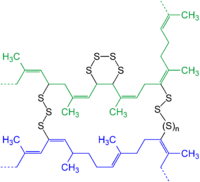
Photo from wikipedia
There has been a tremendous increase in demand for virgin and postconsumer recycled (PCR) polymers due to their wide range of chemical and physical characteristics. Despite the numerous potential benefits… Click to show full abstract
There has been a tremendous increase in demand for virgin and postconsumer recycled (PCR) polymers due to their wide range of chemical and physical characteristics. Despite the numerous potential benefits of using a data-driven approach to polymer design, major hurdles exist in the development of polymer informatics due to the complicated hierarchical polymer structures. In this review, a brief introduction on virgin polymer structure, PCR polymers, compatibilization of polymers to be recycled, and their characterization using sensor array technologies as well as factors affecting the polymer properties are provided. Machine-learning (ML) algorithms are gaining attention as cost-effective scalable solutions to exploit the physical and chemical structures of polymers. The basic steps for applying ML in polymer science such as fingerprinting, algorithms, open-source databases, representations, and polymer design are detailed in this review. Further, a state-of-the-art review of the prediction of various polymer material properties using ML is reviewed. Finally, we discuss open-ended research questions on ML application to PCR polymers as well as potential challenges in the prediction of their properties using artificial intelligence for more efficient and targeted PCR polymer discovery and development.
Journal Title: ACS applied materials & interfaces
Year Published: 2022
Link to full text (if available)
Share on Social Media: Sign Up to like & get
recommendations!